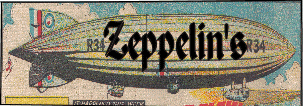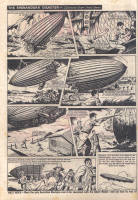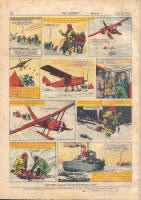
 |
This is a work in progress page.
A Brief Military History of Zeppelins.
Balloons had been used in wars prior to the First World War, notably by the Americans in the civil war and the French during the siege of Paris in 1870. They were used mainly for reconnaissance purposes. This technology had been advanced by the development of dirigibles - cigar shaped airships with frames, containing many gas balloons. Powered with multiple engines, these craft could be flown in specific directions rather than just follow the direction of the wind.
The world’s first Zeppelin L1 flew for fifteen minutes in Germany on the 2nd July, 1900. The rigid airship or dirigible balloon was the brainchild of Count Ferdinand von Zeppelin (08th July, 1838 to 08th March, 1917). The Count spent nearly a decade on developing the airship. Zeppelin had always anticipated that his airship would be used by the military, but it was not taken seriously as a weapon of war and it was instead used initially as a commercial craft. The first passenger flight was made in 1910.
The Zeppelin in the First World War
Germany had seven Zeppelins available for military use at the outbreak of the war, six operated by the army and one by the Navy. The German Army used them to bomb Liege and Antwerp in Belgium , but lost three airships to anti-aircraft fire in the first months of the war. As a result the army was less than enthusiastic about the military use of the craft, but the Navy saw potential in them as reconnaissance airships. Traditionally, navies used cruisers for this job, but the German Navy had very few of these ships. The Zeppelins were seen as the solution to this problem.
Zeppelins were soon being used for reconnaissance patrols over the North Sea . But the German Navy also had plans to use them in an offensive role against Britain to bomb specific targets. A very reluctant Kaiser (Emperor of Germany), agreed the attacks. The first raid was carried out on the 19th January 1915, which killed two people and injured sixteen others. In total there was 52 Zeppelin raids on Great Britain which caused over 500 deaths.
6-7 June 1915, Lieutenant Rex Warneford, RNAS, (Royal Naval Air Service), flying a Morane-Saulnier aeroplane, becomes the first pilot to destroy a Zeppelin (L37) by plane, whilst on a bombing mission against the Zeppelin sheds at Evere, Belgium. (Read the story below). (Warneford was killed ten days later in a flying accident).
The Zeppelin's greatest achievement was in tying up many British squadrons in defending Britain . But as a weapon of war they proved themselves unsatisfactory. Of the 115 Zeppelins employed by the Germans, 53 were destroyed and a further 24 were too damaged to be operational. Zeppelin’s crews suffered a 40% loss rate, whilst the cost of constructing 115 Zeppelins was approximately five times the cost of the damage they inflicted.
After the First World War, Germany fought long and hard to be allowed to continue producing Zeppelins, but this time for commercial purposes. That is as luxury craft flying between continents carrying rich, fare paying passengers. Two of the most famous of these Zeppelins were the Graf Zeppelin LZ 127 and the Hindenburg LZ 129 . The latter Zeppelin coming to grief exploding over the Lakenfield Airfield in America on Thursday, May 6, 1937. The Graf Zeppelinoperated commercially from 1928 to 1937, flew more than 1.7 million km (1,056,000 miles) thus becoming the first aircraft in history to fly over a million miles, made 590 flights, 144 oceanic crossings (143 across the Atlantic, one across the Pacific), carried 13,110 passengers, and spent 17,177 hours aloft (the equivalent of 717 days, nearly two years), all of which was accomplished without ever injuring a passenger or crewman.
Bibliography
http://inventors.about.com/od/xzstartinventors/ss/Zeppelin.htm
http://www.firstworldwar.com/airwar/bombers_zeppelins.htm
http://en.wikipedia.org/wiki/LZ_127_Graf_Zeppelin
Factual events about Zeppelins
The story of a young Brazilian flying his airhip between two locations in Paris, France in 1901. Artwork by Bevan, from the Hotspur comic issue 277.
 |
 |
The first two thumb images (left below) tell the story of the shooting down of German Zeppelin L31 during the First World War. Story from the Hornet 189, artwork by Harry Winslade. The second two images on the right tell the story of a German fighter plane tackling British Observation ballons. Story from the Hornet, issue 181. Artwork by Winslade.
 |
 |
 |
 |
Next we have a story about a runaway British Zeppelin R33 from the Hotspur 263, artist not known. Whilst the two images on the right tell of another accident this time involving an American military Zeppelin the Shenandoah. From the Hotspur, issue 511. Artwork by Leo Rawlings.
 |
 |
 |
 |
The first story below tells of a Zeppelin being used in the Artic on an expedition. From the Hornet, issue 253, artist Shone. The two thumb images on the right are amazing facts about Zeppelins. From the Wizard & Rover and Victor 1964 annual respectively. Artists Bevan and an unkown artist.
 |
 |
 |
 |
Fictional stories about Zeppelins
A German Zeppelin rains down death on a the people of a small village of Gurkhas in the Himalayas. One young Gurkha boy swears vengeance! From The Hornet, issue 25. Artist Carrion?
 |
 |
 |
Follow top British agent The Watcher in action in this story from the Hornet, issue 52. Artwork by Leo Rawlings.
 |
 |
 |
The following World War One adventure of Captain 'Ruthless' Ruff is from the New Hotspur 171 (26th January, 1963). Artist Bevan.
 |
 |
 |